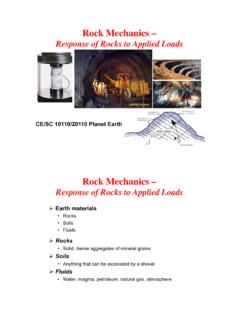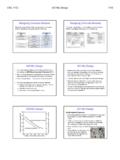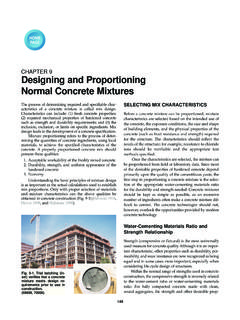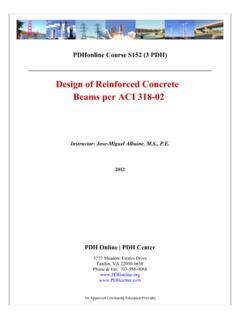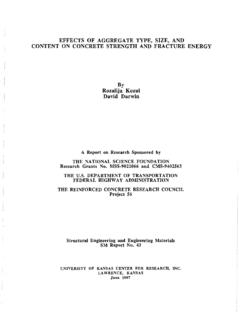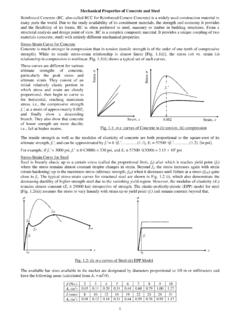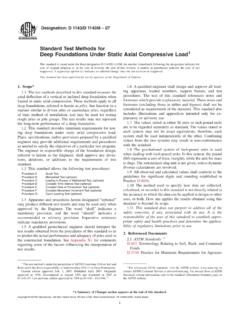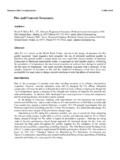Transcription of USING THE POINT LOAD TEST TO DETERMINE THE UNIAXIAL ...
1 USING THE POINT LOAD TEST TO DETERMINE THE UNIAXIAL compressive strength OF COAL. MEASURE ROCK. John Rusnak, Director of Geology Peabody Group St. Louis, MO. Christopher Mark, Rock Mechanics Team Leader National Institute for Occupational Safety and Health Pittsburgh, PA. ABSTRACT is sufficient. This is due in part to the high variability of UCS. measurements. Moreover, the tests are expensive, primarily POINT load testing is used to DETERMINE rock strength because of the need to carefully prepare the specimens to indexes in geotechnical practice. The POINT load test apparatus ensure that their ends are perfectly parallel.
2 And procedure enables economical testing of core or lump rock samples in either a field or laboratory setting. In order to estimate UNIAXIAL compressive strength , index-to- strength THE POINT LOAD TEST. conversion factors are used. These factors have been proposed by various researchers and are dependent upon rock type. This The PLT is an attractive alternative to the UCS because study involved the extensive load frame and POINT load testing it can provide similar data at a lower cost. The PLT has been of coal measure rocks in six states. More than 10,000 used in geotechnical analysis for over thirty years (ISRM, individual test results, from 908 distinct rock units, were used 1985).
3 The PLT involves the compressing of a rock sample in the study. Rock lithologies were classified into general between conical steel platens until failure occurs. The categories and conversion factors were determined for each apparatus for this test consists of a rigid frame, two POINT load category. This allows for intact rock strength data to be made platens, a hydraulically activated ram with pressure gauge and available through POINT load testing for numerical geotechnical a device for measuring the distance between the loading analysis and empirical rock mass classification systems such as points.
4 The pressure gauge should be of the type in which the the Coal Mine Roof Rating (CMRR). failure pressure can be recorded. A state of the art POINT load testing device with sophisticated pressure reading INTRODUCTION instrumentation is shown in Figure 1. The POINT load test (PLT) is an accepted rock mechanics testing procedure used for the calculation of a rock strength index. This index can be used to estimate other rock strength parameters. The focus of this paper is to present the data analysis used to correlate the POINT load test index (Is50) with the UNIAXIAL compressive strength (UCS), and to propose appropriate Is50 to UCS conversion factors for different coal measure rocks.
5 The rock strength determined by the PLT, like the load frame strengths that they estimate, are an indication of intact rock strength and not necessarily the strength of the rock mass. THE UNIAXIAL compressive strength TEST. The UCS is undoubtedly the geotechnical property that is most often quoted in rock engineering practice. It is widely understood as a rough index which gives a first approximation of the range of issues that are likely to be encountered in a variety of engineering problems including roof support, pillar Figure 1. The POINT Load Tester. design, and excavation technique (Hoek, 1977).
6 For most coal mine design problems, a reasonable approximation of the UCS. The International Society of Rock Mechanics (ISRM, Early studies (Bieniawski, 1975; Broch and Franklin, 1985) has established the basic procedures for testing and 1972) were conducted on hard, strong rocks, and found that calculation of the POINT load strength index. There are three relationship between UCS and the POINT load strength could basic types of POINT load tests: axial, diametral, and block or be expressed as: lump. The axial and diametral tests are conducted on rock core samples. In the axial test, the core is loaded parallel to the UCS = (K) Is50 = 24 Is50 (2).
7 Longitudinal axis of the core, and this test is most comparable to a UCS test. Where K is the "conversion factor." Subsequent studies found that K=24 was not as universal as had been hoped, and The POINT load test allows the determination of the that instead there appeared to be a broad range of conversion uncorrected POINT load strength index (Is). It must be corrected factors. Table 1 summarizes published results obtained for to the standard equivalent diameter (De) of 50 mm. If the core sedimentary rocks. Most of the estimates place the conversion being tested is "near" 50 mm in diameter (like NX core), the in a range between 16 and 24, with even lower values for correction is not necessary.
8 The procedure for size correction some shales and mudstones. can be obtained graphically or mathematically as outlined by the ISRM procedures. The value for the Is50 (in psi) is In studies comparing the PLT with the UCS, it is determined by the following equation. generally assumed the UCS test is the standard. In reality, however, UCS tests provide an estimate of the true UCS of Is50 = P/De2 (1) the rock. The accuracy of the estimate depends on the natural scatter in the UCS test results (indicated by the standard P = Failure Load in lbf (pressure x piston area). deviation (SD)) and the number of tests conducted (n).
9 This De = Equivalent core diameter (in). relationship is captured by the concept of the Confidence Interval (CI). For normally distributed data, the 95% CI of As Hoek (1977) pointed out, the mechanics of the PLT the mean is expressed as: actually causes the rock to fail in tension. The PLT's accuracy in predicting the UCS therefore depends on the ratio between SD. the UCS and the tensile strength . For most brittle rocks, the CI 95% = 196.. (3). ratio is approximately 10. For soft mudstones and claystones, n however, the ratio may be closer to 5. This implies that PLT. results might have to be interpreted differently for the weakest rocks.
10 Table 1. Published comparisons between the POINT load and UNIAXIAL compressive strength tests for sedimentary rock. Conversion Reference Rock Type Location Number of tests Comments Factor Western Canada, Das, 1995 Siltstone NG1 lumps, fresh core, old core bituminous coalfields Sandstone/siltstone NG 18. Shale/mudstone NG Freshly blasted rock, Vallejo et al, 1989 Sandstone Eastern KY, VA, WV 420 PLT, 21 UCS irregular lump samples Shale surface coal mines 1,100 PLT, 55 UCS Smith, 1997 Dredge material various harbors NG 8 UCS<1000 psi Dredge material various harbors NG 15 UCS<3500 psi sandstone/limestone unk NG 24 UCS>6000 psi Broch and Franklin, 1972 Various UK (?)










